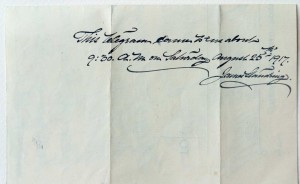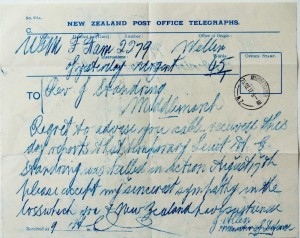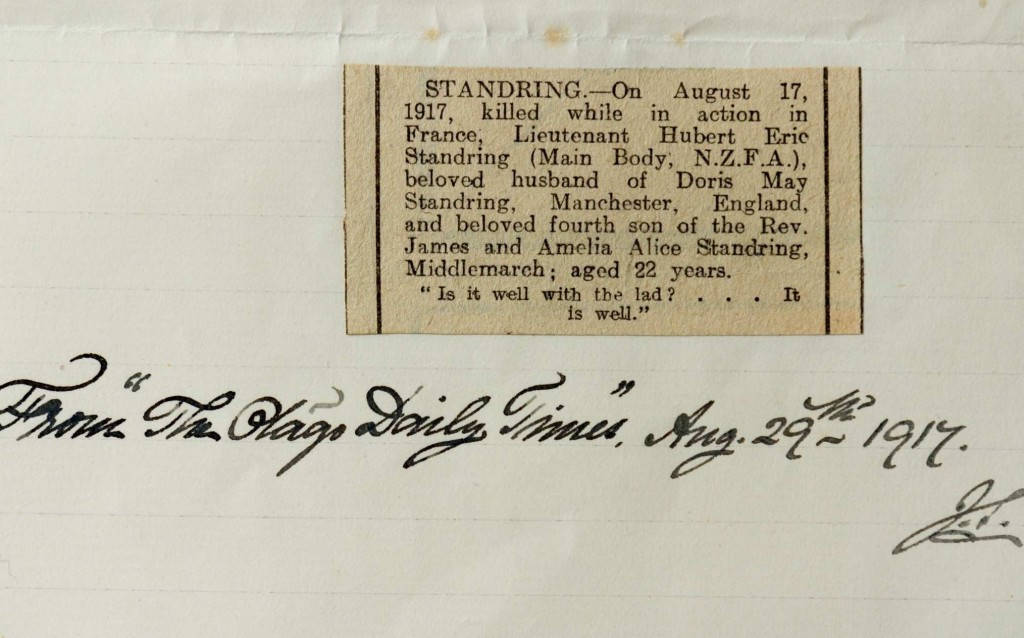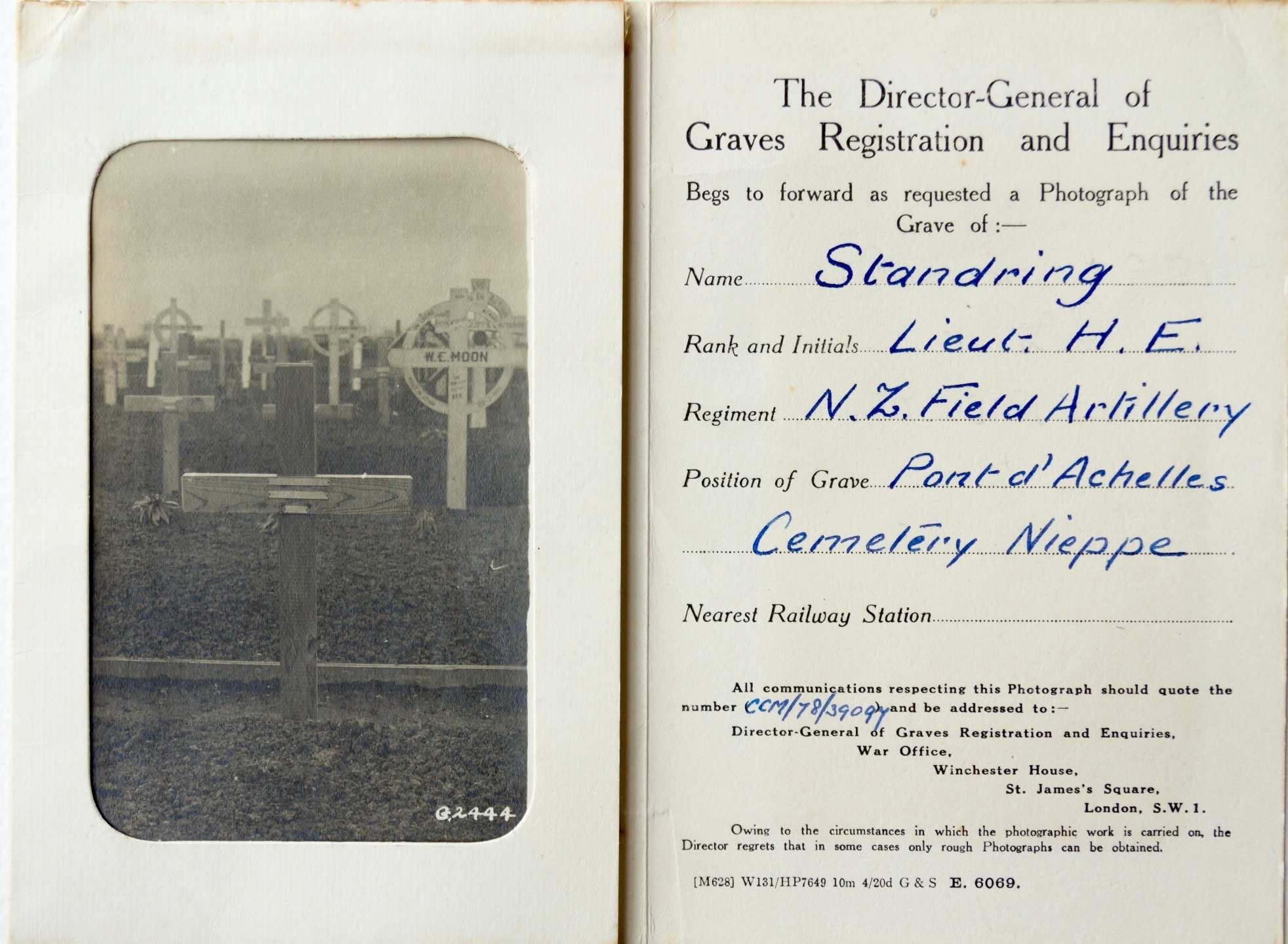(Continued from previous post located HERE)…
TO REDEEM THE PAST:
Glimpses of the Great War based on the letters of Eric Standring
©2014 All Rights Reserved
Death
At about 9.30 am on Saturday, August 25th 1917, the dreaded telegram came to Rev. James Standring in Middlemarch signed J Allen, Minister of Defence.
Regret to advise you cable received this day reports that temporary Lieut H. E. Standring was killed in action August 17th. Please accept my sincerest sympathy in the loss which you and New Zealand have sustained.


Doris forwarded a copy of the letter she received from his commanding officer advising that
He was killed while trying to get an old lady and two little girls away from some buildings that were being the heavily shelled.
Myself and two others went to his assistance as soon as we saw him fall, but his death was instantaneous. He was buried in a military cemetery some distance behind the lines by the Rev. Capt. Tobin.
Hubert Eric Standring was just 22 years old and had served nearly three years in the Army.

Aftermath: Redeem the Past
Reading Eric’s letters there is continuing reference to the need to make his family proud of him. He went to Wellington as a cadet in the Public Works Department but when he enlisted in the OMR he was a commercial traveler in Dunedin. He also mentions several times in his letters that he would like a commission in the Imperial Army where no one knows his past.
Family stories had not provided any clue to this mystery. A search on “Paperspast” (the online newspaper database), finally solved it. A report from the Gisborne Police Court appeared in the“Poverty Bay Herald” on 3 November 1913. It appears that on 15 September 1913, Hubert Eric Standring had left the Public Works Department. He had subsequently called himself Truxton Standbridge, and claiming he still worked for the Public Works Department, got himself accommodation at the Masonic Hotel, Gisborne and ordered a suit of clothes from John Rossbotham . He had not paid for the clothes or the accommodation.
Eric pleaded guilty in the police court of false pretenses for the suit of clothes, valued at 5 pounds.
He also pleaded guilty to supplying liquor to Lawrence Mawson, a prohibited person on 31 October. Police reported that they had “found Mawson lying in a beastly state of drunkenness” with Standring. Mawson was a dentist and Eric said he went there “to learn the trade of dentistry”. Eric admitted supplying liquor to Mawson on more than one occasion. (In 1913 the minimum age for purchasing liquor to take away was still only 13 years so it was not illegal for Eric to buy the alcohol.)
Eric was convicted on both charges. On the false pretenses charge he was placed on probation for six months, directed to abstain during the period of his probation from intoxicating liquor and not enter premises where intoxicants are sold, and to pay John Rossbotham the 5 pounds for the suit of clothes.
On the charge of supplying liquor he was fined 10 pounds and costs of seven shillings with the provision, if he defaulted to serve two months in prison.
It is not clear why Eric left the Public Works Department. The reports of the court case do not appear to have been picked up by the Otago papers.
Memorials
France
Lieutenant Hubert Eric Standring is buried in the Pont-d’Achelles Military Cemetery near Nieppe in Northern France.
The military cemetery at Pont-d’Achelles was begun in June 1917 and used by field ambulances and fighting units until the German advance in the following April. It was used by the Germans during their occupation, under the name of Papot Military Cemetery, and it was resumed by the British in September and October 1918. The cemetery contains 293 Commonwealth and 37 German burials from the First World War (the Cemetery having briefly been under German control).
In 1919 Rev Standring wrote to Padre Tobin asking if he had a photo of the grave. The Padre advised him that they were not allowed to have cameras in France. Contrary to the information Doris had received Padre Tobin did not bury Eric. He had looked back and seen a diary entry saying he had seen the grave. He notes “the graves are well cared for and different from those up the line”. Padre Tobin also notes that he was camped with the 3rd Otagos in Port Nieppe.
He was killed the day we went up the line. The Hun was shelling some “Archies” – aeroplane guns and they lengthened a few hundred yards…Your son was helping an old woman escape when a shell burst on the road killing him instantly.
Subsequently a card came from the War Office with a photo of the grave.

Salford
Doris had a plaque put on grave of her mother. It is still visible on the grave in St Pauls, Kersal Moor in Salford.
Also Lieut H. E. Standring the beloved husband of Doris Standring and son in law of the above killed in action in France – August 17, 1917
New Zealand
On 11 September 1917 the Otago Daily Times told of a service in Middlemarch (where Rev James Standring was now the minister).
MEMORIAL SERVICE AT MIDDLEMARCH.
On Sunday afternoon one of the largest congregations that have assembled in Middlemarch gathered in the A. and P. Hall to take part in a memorial service to the soldiers who have fallen during the war. During the past week or two the grim and tragic nature of the conflict has been brought home poignantly to the people of the district by the deaths of Lieutenant Eric Standring and Private Alec. Robertson, who were killed at the front. The hall was packed to the door and the Rev. Mr Standring (father of Lieutenant Standring) conducted the service. Ten wreaths, one for each of the boys from the district who have given their lives for the Empire and the cause of freedom, were ranged in front of the platform, and the reading desk was draped with the Union Jack.
The members of the Middlemarch Band, Territorials, and Senior Cadets, and the members of the Oddfellows’ and Freemason Lodges marched to the hall in procession, and the flags outside the, hall were flown at half-mast.
Taking for his text the words “Greater love hath no man than this, that a man lay down his life for his friend,” the Rev. Mr Standring delivered a most eloquent and touching address……
The address moved the audience powerfully. Appropriate hymns were sung, and the meeting closed with the benediction.
Eric is not included on the Middlemarch War Memorial. His name is on the Enfield Memorial gates in North Otago.
Waitaki Boys’ High School, Eric’s old school has an impressive Hall of Memories. About 700 old boys served during the First World War, 119 of them dying. His name is included on the memorial.
Eric is also remembered in a memorial in the Waiareka Presbyterian Church. There is a framed photo with an inscription on the back from Rev. James noting that it was unveiled on Sunday, 7 December 1919.
Postscript
Tom Mansergh died in 1920 and is buried with his wife Grace in the churchyard of St Pauls, Kersal Moor, Salford, England. There is a memorial to Eric on the headstone.
Doris Standring married Frank Arthur Harrison, an accountant, in 1927. He had also been a soldier and had been awarded the Military Cross. They do not appear to have had any children. She died in 1955.
Gladys Hull (nee Standring) had a disastrous first marriage to a man who had left his wife and children in Scotland. She married again and had over 20 happy years with Horace Hull. Horace died in 1951 while visiting Wellington. Gladys lived in Warrington, Karitane, and Dunedin until her death in January 1987 at the age of 90. She always remembered Eric and kept his letters and postcards.
Victor Tainui (Vic) Standring served in the New Zealand Merchant Navy in both the 1st and 2nd World Wars. He married in England in 1918 and brought his bride back to New Zealand. He had a distinguished career as an Engineer in the Union Steam Ship Company and died in 1962.
Rev. James Standring retired as a Minister in 1924 and died in 1928.
Amelia Alice (Millie) Standring lived until August 1957. She was 92.
Sources
- Letters and postcards sent by Eric Standring
- Military Personnel Files – STANDRING, Hubert Eric – WW1 9/481 – Army; Archives New Zealand
- PapersPast; National Library of New Zealand
- Damien Fenton, New Zealand and the First World War 1914 – 1919, Penguin, 2013
- Don MacKay (ed),The Troopers Tale, the History of the Otago Mounted Rifles, Turnbull Ross Publishing, 2012
Sue Guest/©2014 All Rights Reserved
(If you have missed reading parts of this series, please Start Here)

